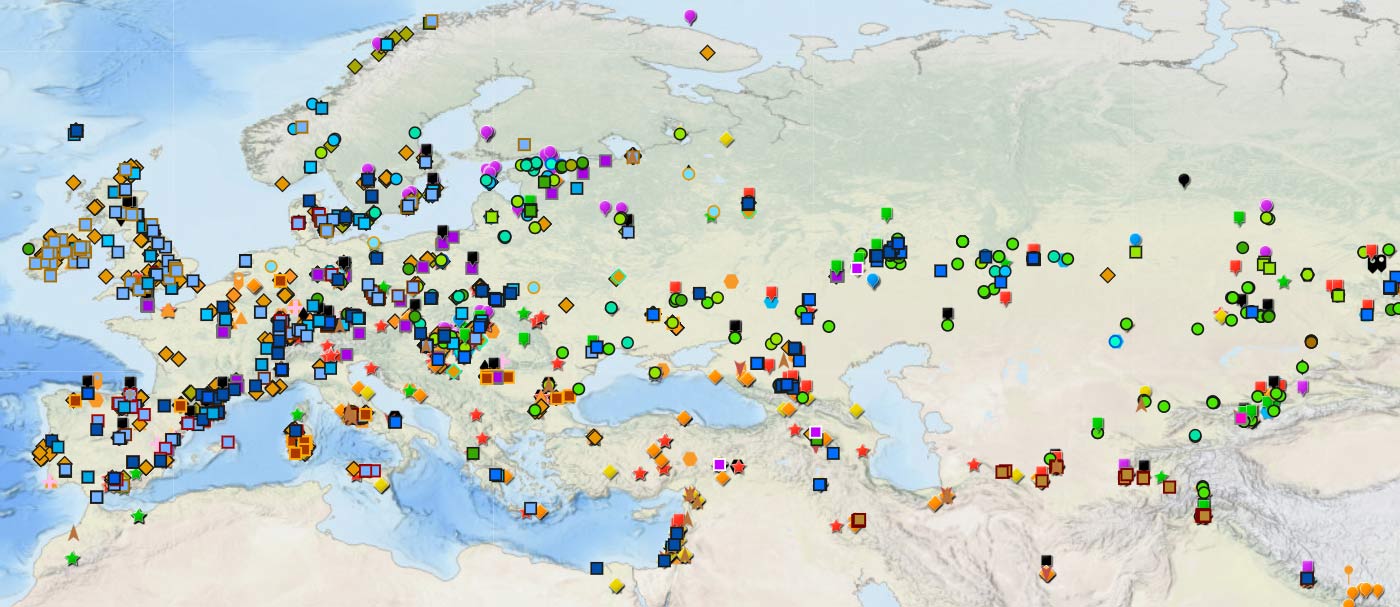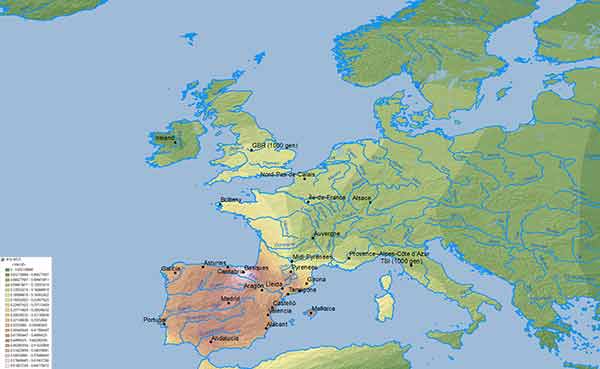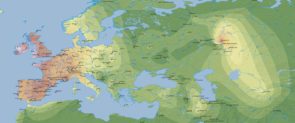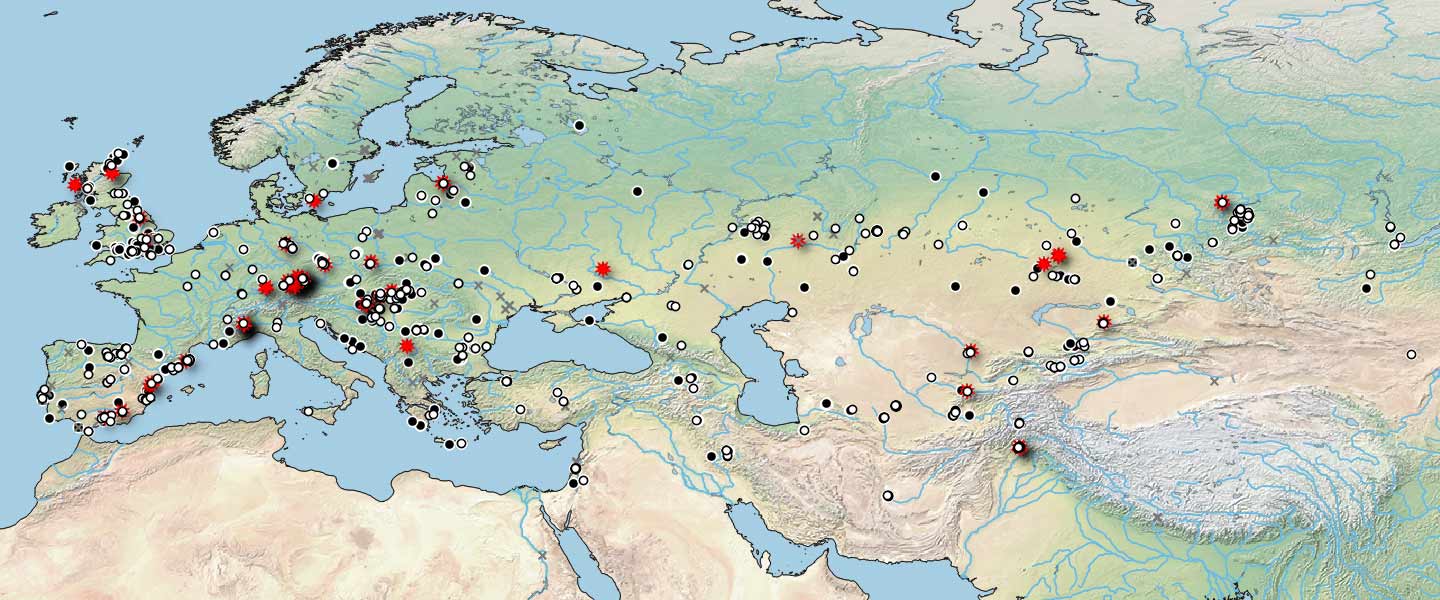The Reich Lab has recently pre-published high quality shotgun sequencing data from 216 ancient individuals within the framework of the Allen Ancient Genome Diversity Project / John Templeton Ancient DNA Atlas. Metadata for the 216 genomes are available here.
Their median coverage is 4.9x, and among them there are 50 high coverage genomes (17-36x), but there are also samples with a coverage similar to the previously published ones.
The FamilyTreeDNA Haplotree team formed by phylogeneticist Michael Sager and Göran Runfeldt from the R&D team has analyzed all 129 males for Y-SNP calls, using – and updating with them – their database of more than 40,000 branches as of March 2021. Of course, the main source of SNP data for their haplotree comes from modern Big Y testers, whose hope is usually to find matches among modern and ancient testers, to expand their genealogical tree or get an idea of the ancestral origins of their patrilines.
NOTE. I am not affiliated to FTDNA in any form, and I cannot help you decide for one or another test. My advice, if you want to get a test for yourself or a family member, would be to join some online group or contact experts online, and if possible wait for one of the various discounts that are offered at different times of the year. I am sure there are a lot of people willing and able to help you with this.

I have added all new Y-SNP calls with their updated position in the haplotree in the Ancient DNA Dataset. Notice that the new shotgun-sequenced analyses are underlined (Object-ID and responsible-SNP columns), with a reference to SG in the responsible-SNP column. Also, the column for coverage on autosomal targets has been modified if the shotgunned sample has better coverage (green background).
You can find samples visually with the ArcGIS Online Map, and in short also through AncientDna.info. For modern FTDNA testers and their location relative to ancient ones, my advice is to use SNP Tracker. Some specific branches might be still inactive in the Y-DNA Haplotree, but they will probably be updated today.
The following is a list of samples with some highlights and short comments on some of the most interesting findings, as far as I can tell at first sight. Other samples with Y-SNP calls by FTDNA are occasionally listed for comparison (using a smaller font size). Feel free to comment below if you see something else.
- I2514 • T-Y13309 • Tepe_Hissar_C • Tepe Hissar (2471-2299 calBCE)
- SZ42 • R-P312 • Longobard migration • Szólád, Hungary (412-604 CE).
- I4073 • R-P312 • BK_Netherlands_Tui • De Tuithoorn, Oostwoud, Noord-Holland (2197-1897 calBCE).
- I5748 • R-Z302 • BK_Netherlands_Tui • De Tuithoorn, Oostwoud, Noord-Holland (2579-2211 calBCE).
- I2860 • R-Z30597 • Scotland_LBA • Covesea Cave 2, Moray, Scotland (969-812 calBCE).
- I3132 • R-S5488 • Scotland_CA_EBA • Covesea Cave 2, Moray, Scotland (2126-1886 calBCE).
- I2859 • R-FGC12055 • Scotland_LBA • Covesea Caves, Moray, Scotland (912-808 calBCE).
- I2445 • R-BY132302 • BK_England_SOU • Yarnton, Oxfordshire, England (2200-1985 calBCE).
- I3123 • R-Z198 • Sicily_EBA • Sicily, Buffa (2287-2041 calBCE).
- I6470 • R-FT10154 • Cogotas I • Virgazal, Tablada de Rudrón, Burgos, Castilla y León (1746-1540 calBCE).
- I4889 • R-P312(U152+,L2+) • BK_Czech_CZE • Prague 8, Kobylisy, Ke Stírce Street (2284-2056 calBCE).
- I7249 • R-L2 • Bell_Beaker_Czech • Brandysek (2138-1973 calBCE).
- I7278 • R-L2 • Bell_Beaker_Czech • Brandysek (2462-2298 calBCE).
- I7212 • R-L2 • • Radovesice (2454-2201 calBCE).
- I7286 • R-L2 • BK_Czech_CZE • Radovesice (2403-2199 calBCE).
- I7289 • R-P312(L2+) • BK_Czech_CZE • Radovesice (2456-2209 calBCE).
- I4888 • R-Z46080 • BK_Czech_CZE • Prague 8, Kobylisy, Ke Stírce Street (2195-2027 calBCE).
- I5835 • R-DF110 • BK_Germany_BAV • Irlbach, County of Straubing-Bogen, Bavaria (2500-2000 BCE).
- I3387 • R-FT406553 • Afanasievo Middle Yenisei • Middle Yenisei region, Afanasieva Gora (2950-2600 BCE).
- I5279 • R-FTA29814 • Afanasievo Tyumechin • Lower Tyumechin 1 (3011-2897 calBCE).
- I3952 • R-Z2109 • Afanasievo Karasuk • Altai Mountains, Yenisey River, left bank of Karasuk tributary, Karasuk III (2868-2577 calBCE).
- I5277 • R-Z2109 • Afanasievo Elo • Elo Bashi (3092-2923 BCE).
- I5269 • R-Z2109 • Afanasievo Elo • Elo 1 (3016-2897 calBCE).
- I5273 • R-BY185688 • Afanasievo Tyumechin • Lower Tyumechin 1 (3011-2885 calBCE).
- I4432 • R-A11291 • Latvia_HG • Zvejnieki (6072-5920 calBCE).
- I4439 • R-FTA35787 • Latvia_HG • Zvejnieki (5769-5628 calBCE).
- I4434 • R-FTA35785 • Latvia_HG • Zvejnieki (5611-5382 calBCE).
- I4436 • R-FTA35785 • Latvia_HG • Zvejnieki (4318-4051 calBCE).
- I4916 • R-FT360000 • Iron_Gates_HG • Hadučka Vodenica (7035-6590 calBCE).
- I5232 • R-FTA35718 • Iron_Gates_HG • Padina (6061-5841 calBCE).
- I5237 • R-FT370000 • Iron_Gates_HG • Padina (9300-5800 BCE).
- I5235 • R-FTA35749 • Iron_Gates_HG • Padina (9221-8548 calBCE).
- I5240 • R-FTA35749 • Iron_Gates_HG • Padina (9140-8570 calBCE).
- I1734 • R-PF6362 • Ukraine_Mesolithic • Vasil’evka (7451-7056 calBCE).
- I4315 • R-BY14355 • Dzharkutan_BA • Dzharkutan (1540-1455 calBCE).
- I1819 • R-M459 • Ukraine_Mesolithic • Vasil’evka (9107-8556 calBCE).
- I3389 • R-S23592 • Krasnoyarsk_MLBA • Krasnoyarsk Krai, Orak burial (1900-1400 BCE).
- I3394 • R-S23592 • Krasnoyarsk_MLBA • Krasnoyarsk Krai, Orak burial (1900-1400 BCE).
- I3392 • R-FGC56408 • Krasnoyarsk_MLBA • Krasnoyarsk Krai, Orak burial (1900-1400 BCE).
- I3396 • R-FGC56408 • Krasnoyarsk_MLBA • Krasnoyarsk Krai, Orak burial (1900-1400 BCE).
- I6718 • R-FGC56408 • Krasnoyarsk_MLBA • Krasnoyarsk Krai, Orak burial (1615-1466 calBCE).
- I1053 • R-Y874 • Western_Steppe_MLBA • Kamennyi Ambar 5 Cemetery (1928-1751 calBCE).
- I4773 • R-YP4132 • Western_Steppe_MLBA • Aktogai (1613-1508 calBCE).
- I1947 • R-M124 • Ganj_Dareh_N • Ganj Dareh (8211-7827 calBCE).
- I7492 • R-FGC13203 • Sappali_Tepe_BA • Sappali Tepe (2010-1779 calBCE).
- I11974 • Q-M902 • Southern_Cone • Los Rieles, Los Vilos, Coquimbo (10420-9450 calBCE).
- I1752 • Q-FT276830 • Southern_Cone • Conchalí, Santiago, RM (1300-1410 calCE).
- I15676 • Q-SK1572 • Caribbean_Ceramic • La Caleta (1444-1618 calCE).
- I15601 • Q-FTA3935 • Caribbean_Ceramic • La Caleta (667-774 calCE).
- I5319 • Q-FTA37711 • Athabaskan • Tochak McGrath, Upper Kuskokwim River, Alaska (1050-1400 calCE).
- I1524 • Q-A15256 • Old Bering Sea • Ekven, Chukotka (830-1260 calCE [union of two dates: 900-1260 calCE).
- I14879 • Q-L456 • Caribbean_Ceramic • South Andros Island (Sanctuary Blue Hole). (1274-1380 calCE).
- I6356 • Q-Y12449 • Sagly • Uvs aimag, Ulaangom sum, Chandman Uul, Ulaangom cemetery, Grave #58, Burial 2 (400-200 BCE).
- I6348 • Q-FT421589 • Munkh-Khairkhan • Bulgan, Khutag-Undur sum, Haruulyn Gozgor (1749-1617 calBCE).
- I7039 • Q-FTA37655 • Mongolia_LBA_CenterWest • Khovd, Duut sum, Khoit Tsenkheriin gol 1988 barrow 3 (1210-1019 calBCE).
- I6232 • Q-FTA37701 • Sagly • Uvs aimag, Ulaangom sum, Chandman Uul, Ulaangom cemetery Grave #48, Burial 6 (387-208 calBCE).
- I1526 • Q-BZ2222 • Ust’-Belaya • Ust’-Belaya II, Angara river (2910-2700 calBCE).
- I4550 • Q-Y2700 • Latvia_HG • Zvejnieki (6633-6470 calBCE).
- I6717 • Q-F2019 • Steppe_MLBA_oESHG • Krasnoyarsk Krai, near Orak Ulus, Orak burial place (1498-1403 calBCE).
- I4784 • Q-BZ4911 • Steppe_MLBA_oBMAC • Kyzyl Bulak 1 (1613-1508 calBCE).
- I3949 • Q-FT380500 • Afanasievo Karasuk • Altai Mountains, Yenisey River, left bank of Karasuk tributary, Karasuk III (2844-2496 calBCE).
- I3950 • Q-FT380500 • Afanasievo Karasuk • Altai Mountains, Yenisey River, left bank of Karasuk tributary, Karasuk III (2879-2632 calBCE).
- I6714 • Q-FT380500 • Afanasievo Karasuk • Altai Mountains, Yenisey River, left bank of Karasuk tributary, Karasuk III (2618-2468 calBCE).
- I6555 • L-Y87534 • Loebanr_IA • Swat Valley, Loebanr (906-816 calBCE).
- I1632 • L-FTA37789 • Areni_CA • Areni (4236-3994 calBCE).
- I5950 • E-BY75850 • Mota.SG • Mota Cave, Gamo Highlands (2576-2465 calBCE).
- I1730 • J-FTA1458 • • ‘Ain Ghazal (2557-2296 calBCE).
- I5078 • J-Z36829 • Sopot_MN • Osijek (4699-4545 calBCE).
- I0708 • J-Z43590 • Barcın Neolithic • Barcın, Marmara Region, Northwest Anatolia (6224-6074 calBCE).
- I7421 • J-MF10501 • Sappali_Tepe_BA • Sappali Tepe (1935-1751 calBCE).
- I4229 • I-F1295 • BK_Portugal_POR • Cova da Moura, Torres Vedras, Lisboa (2287-2141 calBCE).
- I1763 • I-FT344596 • Ukraine_Mesolithic • Vasil’evka (8282-7960 calBCE).
- I5236 • I-BY33164 • Iron_Gates_HG • Padina (8291-7826 calBCE).
- I1507 • I-FTA37506 • Körös Early Neolithic • Tiszaszolos-Domahaza (5788-5640 calBCE).
- I7042 • I-M838 • Hungary MN • Szigetszentmiklós-Üdülősor (4239-4046 calBCE).
- I6696 • I-Y78027 • Corded_Ware_Czech_EN • Velké Žernoseky (2900-2350 BCE).
- I4440 • I-FTA37476 • Latvia_HG • Zvejnieki (5216-5016 calBCE).
- I4438 • I-FTA37476 • Latvia_HG • Zvejnieki (5375-5216 calBCE).
- I1495 • I-FTA37509 • Lengyel_LN • Apc-Berekalya (4496-4353 calBCE).
- I3133 • I-BY95958 • Scotland_N • Raschoille Cave, Oban, Argyll and Bute, Scotland (3627-3377 calBCE).
- I2637 • I-A1150 • Scotland_N • Holm of Papa Westray North, Orkney, Scotland (3510-3340 calBCE).
- I2978 • I-BY37286 • Scotland_N • Isbister, Orkney, Scotland (3336-3024 calBCE).
- I7554 • I-BY37286 • Scotland_N • Unstan, Orkney, Scotland (3368-3102 calBCE).
- I2935 • I-BY37270 • Scotland_N • Isbister, Orkney, Scotland (3336-2939 calBCE).
- I2932 • I-FT368016 • Scotland_N • Isbister, Orkney, Scotland (2572-2348 calBCE).
- I1738 • I-L703 • Ukraine_Neolithic • Vovnigi (5475-5320 calBCE).
- I4596 • I-PH5234 • Latvia_HG • Zvejnieki (6069-5984 calBCE).
- I4553 • I-FT370114 • Latvia_HG • Zvejnieki (5480-5375 calBCE).
- I4551 • I-FT370114 • Latvia_HG • Zvejnieki (5788-5663 calBCE).
- I4914 • I-FTA37531 • Iron_Gates_HG • Hadučka Vodenica (6360-5986 calBCE).
- I4881 • I-L801 • Iron_Gates_HG • Vlasac (6570-6255 calBCE).
- I4441 • I-L801 • Latvia_HG • Zvejnieki (4841-4711 calBCE).
- I4880 • I-FTA37515 • Iron_Gates_HG • Vlasac (6000-5725 calBCE).
- I4882 • I-FTA37515 • Iron_Gates_HG • Vlasac (6200-5900 BCE).
- I2650 • I-S21760 • Scotland_N • Holm of Papa Westray North, Orkney, Scotland (3500-3360 calBCE).
- I4878 • I-Y7240 • Iron_Gates_HG • Vlasac (5995-5710 calBCE).
- I3134 • I-BY166411 • Scotland_N • Raschoille Cave, Oban, Argyll and Bute, Scotland (3630-3377 calBCE).
- I2660 • I-BY168618 • Scotland_N • Distillery Cave, Oban, Argyll and Bute, Scotland (3515-3357 calBCE).
- I3135 • I-Y3712 • Scotland_N • Raschoille Cave, Oban, Argyll and Bute, Scotland (3638-3386 calBCE).
- I2691 • I-FT109337 • Scotland_N • Distillery Cave, Oban, Argyll and Bute, Scotland (3710-3632 calBCE).
- I5838 • I-BY37404 • C_Iberia_CA • El Mirador Cave, Atapuerca, Burgos, Castilla y León (2900-2300 BCE).
- I7272 • I-Y52134 • Czech_Eneolithic • Brandýsek (3624-3376 calBCE).
- I4915 • I-S2599 • Iron_Gates_HG • Hadučka Vodenica (6340-5990 calBCE).
- I11459 • H-M2772 • Shahr_I_Sokhta_BA2 • Seistan, Shahr-i Sokhta (2874-2630 calBCE).
- I2520 • H-FT369003 • Bulgaria_BA • Dzhulyunitsa (3336-3029 calBCE).
- I0709 • H-BY102409 • Barcın Neolithic • Barcın, Marmara Region, Northwest Anatolia (6223-6034 calBCE).
- I0745 • H-SK1180 • Barcın Neolithic • Barcın, Marmara Region, Northwest Anatolia (6387-6111 calBCE).
- I16168 • H-Z19089 • Sardinia_Nuragic_BA • Sardinia, Anghelu Ruju (3949-3714 calBCE).
- I2367 • G-PF3345 • Hungary_Baden_LCA • Budakalász (3333-2928 calBCE).
- I2431 • G-S10654 • Bulgaria_Middle_Chalcolithic • Ivanovo (4784-4552 calBCE).
- I3125 • G-CTS5990 • Sicily_EBA • Sicily, Buffa (1612-1501 calBCE).
- I2521 • G-F2214 • Dzhulyunitsa-Smardesh EN • Dzhulyunitsa (5621-5481 calBCE).
- I4893 • G-FTA29811 • • Prague 8, Kobylisy, Ke Stírce Street (4446-4347 calBCE).
- I2510 • G-FTA37257 • Bulgaria_BA • Dzhulyunitsa (2907-2704 calBCE).
- I1583 • G-FGC2315 • Barcın Neolithic • Barcın, Marmara Region, Northwest Anatolia (6424-6233 calBCE).
- I1131 • G-FT370002 • Vinca_MN • Gomolava, Hrtkovci, Vojvodina (4653-4452 calBCE).
- I5077 • G-FGC55322 • Sopot_MN • Osijek (5208-4942 calBCE).
- I7420 • G-Z36520 • Sappali_Tepe_BA • Sappali Tepe (2000-1600 BCE).
- I4089 • C-Z29332 • Romania_Chalcolithic • Urziceni (3765-3640 calBCE).
- I1496 • C-FT251391 • LBK_Hungary_MN • Apc-Berekalya (5211-4958 calBCE).
- I5070 • C-FT251331 • LBK_Austria • Schletz (5209-4998 calBCE).
- I7021 • C-B77 • Mongolia_N_East • Dornod aimag, Bulgan sum, Norovlin Uul burial (5211-4995 calBCE).
- I11696 • C-FTA37248 • Mongolia_N_North • Bulgan, Khutag-Undur sum, Marzyn khutul (5632-5484 calBCE).
- I11697 • C-FTA37248 • Mongolia_N_North • Bulgan, Khutag-Undur sum, Marzyn khutul (5620-5481 calBCE).
- I6228 • C-Y11606 • Xiongnu • Uvs aimag, Ulaangom sum, Chandman Uul, Ulaangom cemetery Grave #44 (40 calBCE – 109 calCE).
- I10873 • B-CTS162 • Cameroon Late Holocene • Shum Laka (1217-1055 calBCE).
- I10871 • A-L1087 • Cameroon Early Holocene • Shum Laka (6058-5889 calBCE).
T-M70
This one is added to the already analyzed T-M70 samples:
CL23 • T-BY45363 • Longobard Kingdom • Collegno, Italy (580-630 CE)
VK398 • T-BY215080 • Viking Sweden • Skara (900-1200 CE)
VK17 • T-Y138678 • Viking Russia • Ladoga (900-1200 CE)
SZ36 • T-Y15712 • Longobard migration • Szólád, Hungary (412-604 CE)
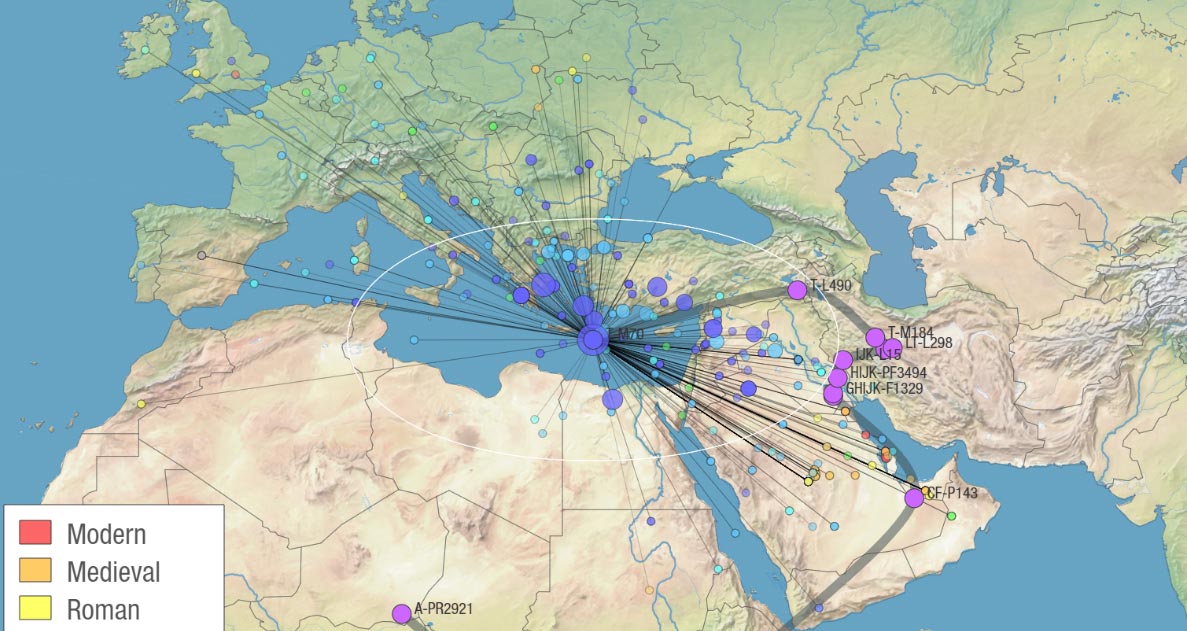
R1b-M269
R1b-L51
Recent analyses by FTDNA show among others the following ancient L51:
I6222 • R-P310 • Afanasievo Bayankhongor aimag • Bayankhongor aimag, Erdenetsogt sum, Shatar chuluu kurgan 2 (3320-2918 calBCE).
In the oral communication by David Anthony, he referred to the obvious strict patrilineal society of the Yamnaya, but with a caveat: while almost all males sampled show R1b-L23 subclades, individuals interred in the same or nearby sites were usually not directly related to each other within less than 4 generations.
One of the most interesting revelations of the year, at least for the confirmation of mainstream linguistic theories concerning PIE, is the finding of IBD sharing among 4 samples closely related to each other, descended from the same individual 5-7 generations before, despite being separated by thousands of km.: Yamnaya males from the Carpathian Basin and Moldova, an Afanasievo male, as well as one Yamnaya female from the Samara region.
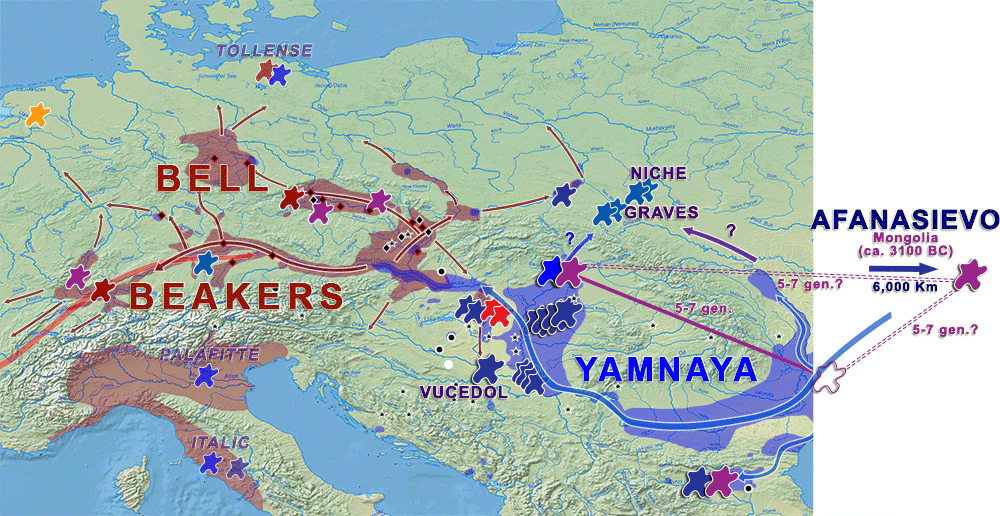
Since the referred Yamnaya male from Eastern Slovakia is probably one of those L51 with an ancestry intermediate between Yamnaya and Bell Beakers hinted in Szécsényi-Nagy’s oral communication, it would mean that either the three males are all descended from the same basal R-P310* as this Afanasievo individual, or that they are of different (L51 and Z2103) subclades but related through mixed family ties.
In any case, you could not get a nicer indirect confirmation of the proposed cultural and linguistic origin of all Late Proto-Indo-European dialects in population genomics, even if you planned for it.
R-L151>A8053
I7043 • R-A8053 • proto-Nagyrév • Szigetszentmiklós-Üdülősor (2138-1973 calBCE).
NOTE. His brother I7041 (P310+) joins him in this haplogroup assignment.
These samples of the proto-Nagyrév culture – local continuation of the Yamnaya in the Carpathian Basin – who display ca. 40% Yamnaya ancestry were previously believed to be basal L151* (with one ancestral call for A8053). They have turned out to be basal R-A8053*, and as such they are the first (and only) ones of this haplogroup to appear in ancient DNA. This offers further support to the role of the Yamnaya from the Carpathian Basin as the immediate origin of Bell Beakers.
The presence of known R-L151 branches in the region as Yamnaya-derived locals – before being replaced by intrusive steppe-rich Csepel Bell Beakers of hg. R-Z2103 (with ancestral roots in Moravia) shows how genetic data from the mid-3rd millennium in Central Europe cannot be interpreted without a proper archaeological assessment of the complex population movements in the region.
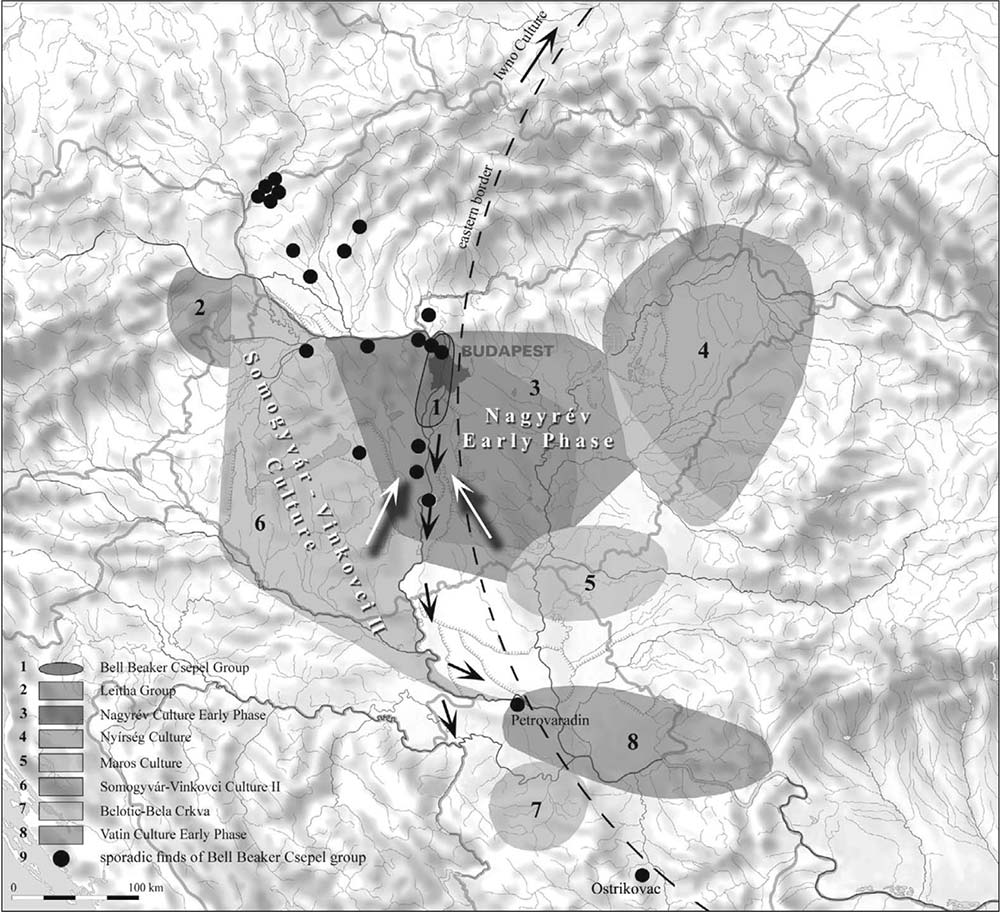
This is yet another example of how modern testers can often distort the real picture of ancient DNA. In this case, as in many others, because of the clear overtesting among peoples descended from Northern and North-Western Europeans.
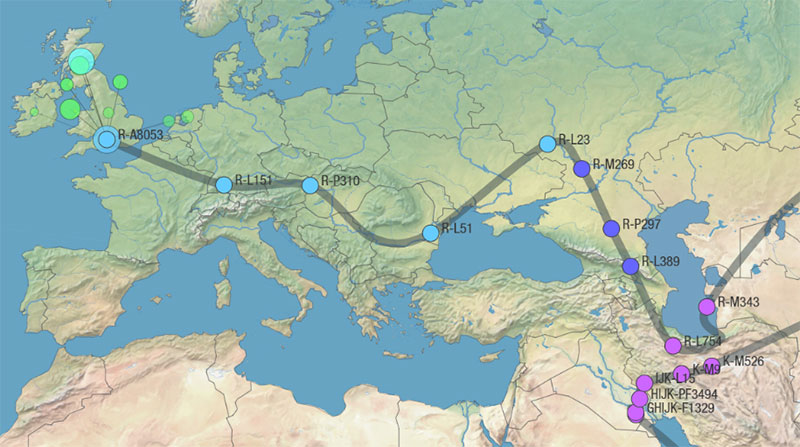
R-L151>P312
The fact that a basal R-P312* line from Oostwoud is not found in modern descendants, despite the region being well represented among FTDNA customers, suggests that this specific P312 lineage is a dead end.
R-L151>P312>DF19
Other ancient R-DF19 samples analyzed by FTDNA include the following:
6DT23 • R-S4268 • England Roman gladiators • Driffield Terrace (50-350 CE)
VK333 • R-Z29034 • Viking Sweden • Oland (772-1014 calCE).
R31 • R-BY3448 • Late Antiquity Rome • Mausoleo di Augusto (261-535 calCE).
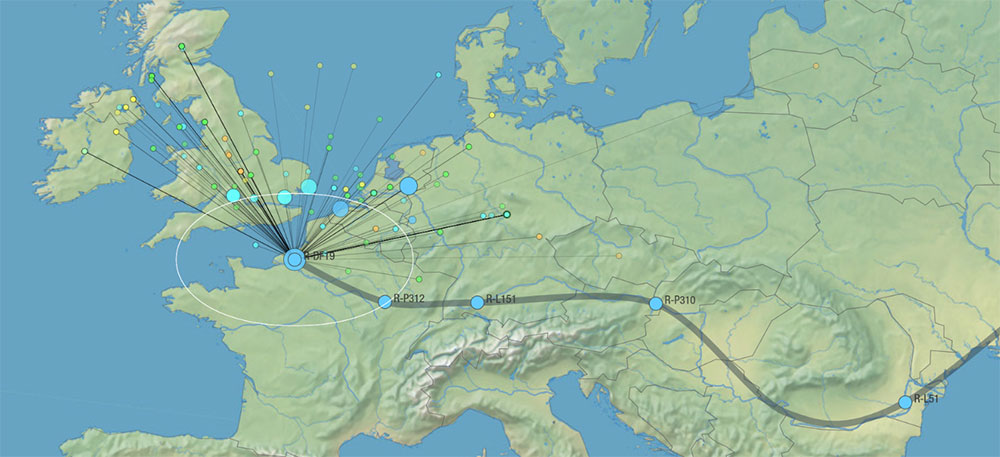
R-L151>P312>FGC84729
Other R-FGC84729 samples analyzed by FTDNA include the following:
CL94 • R-DF99 • Longobard Kingdom • Collegno, Italy (580-630 CE).
VK336 • R-BY106906 • Viking Sweden • Oland (707-990 calCE ).
VK369 • R-FT108043 • Viking Denmark • Sealand (850-900 CE).
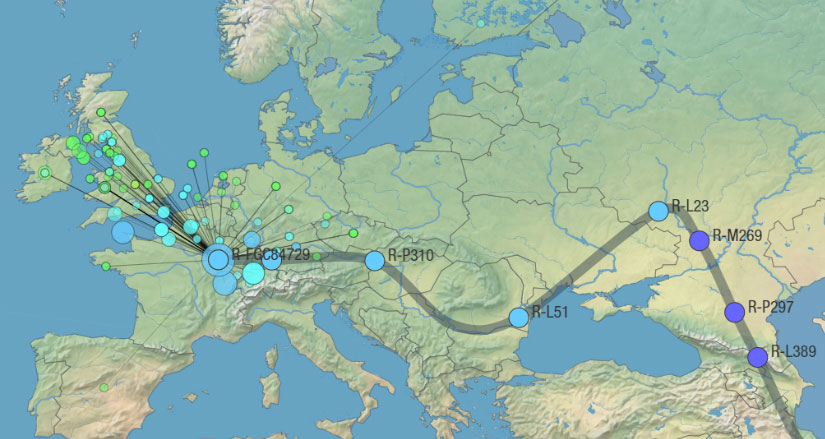
R-L151>P312>Z290>L21>DF13
There are many ancient R-DF13 tested by FTDNA. The most relevant one for these newly shotgun-sequenced ones is probably a Pict sampled from Orkney (another one is I-Y3712, see below):
VK203 • R-BY10450 • Pict Orkney • Orkney (54-668 CE).
According to the recent talk by David Reich, there is as much as 50% population replacement during the MBA-LBA transition in Great Britain, marked by an increase in EEF-related ancestry, suggesting that Celtic languages started spreading into the British Isles at roughly the same time or slightly later than they spread into Iberia. The survival of Bell Beaker lineages in Scotland might be a key to understand (at least in population genomics) the ethnic background of Picts.
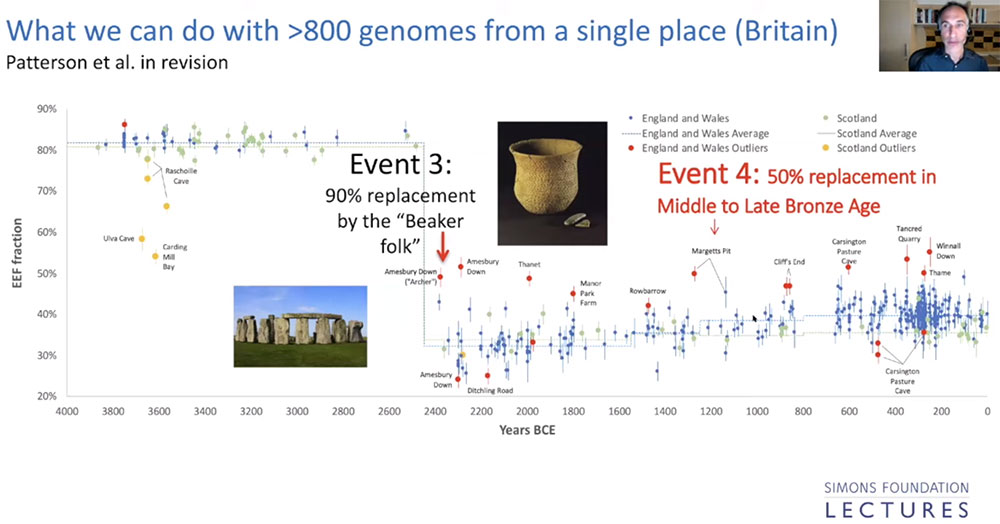
R-L151>P312>ZZ11>DF27
I6470 splits the current R-FT9510 branch.
Of note, one of the earliest radiocarbon-dated R1b-L23 samples available to date in Europe also comes from the Sicily_EBA group, and is probably DF27>Z195, too:
I11443 • R-P312 • Sicily_EBA • Sicily, Buffa (2872-2476 calBCE).
NOTE. Of course, radiocarbon dates cannot be taken out of cultural (and now also genetic) context. In this case, all other Buffa Cave II materials show BBC & Capo Graziano pottery and similar (much later) radiocarbon dates, with a late date of steppe-related intrusion, ergo this sample and its radiometric assessment need to be rechecked or else ignored. We have seen that problem already with the Alexandria sample, with the Hajji Firuz sample, and quite evidently also with those “earliest” Steppe-related Switzerland_LN samples.
R-L151>P312>ZZ11>U152>L2
Some of these are basal R-L2*, without a modern relative, which – as in the Netherlands – attests to the mix of dead ends and surviving patrilines in the context of Czech Bell Beakers.
R-L151>P312>ZZ11>U152>L2>Z46080
This new L2 subclade is formed together with another sample from (Central-)Western Europe.
R-L151>P312>ZZ11>U152

Another ancient of hg. R-DF110 has been analyzed to date:
R33 • R-DF110 • Late Antiquity Rome • Mausoleo di Augusto (300-700 CE).
This haplogroup is today also prevalent in (North-)Western Europe, as opposed to the likely prevalence in Central(-Eastern) Europe during the expansion of East Bell Beakers.
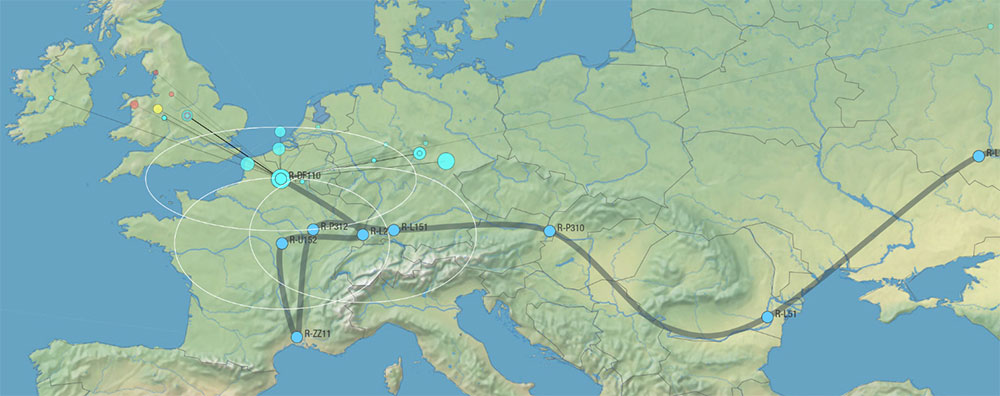
R-Z2103
R-Z2103>M12149>FT406553
Forms a new branch under R-M12149 with I6712:
I6712 • R-FT406553 • Afanasievo Middle Yenisei • Middle Yenisei region, Afanasieva Gora (2857-2501 calBCE )
R-Z2103>M12149>FTA29814
Apparently forms a new branch under R-M12149 with a modern sample from the Western Balkans.
R-Z2103>M12149>Z2109
I5273 apparently forms a new branch with a modern tester from Italy. Even though three of the samples remain basal – and are as such each one of them potential dead ends relative to modern populations – the number of testers from Asia is comparatively very limited, so it is hard to draw any conclusions about their survival into the present day.

R-M73
Most early North-Eastern European R-M73 samples seem to belong to the FTA35755 subclade, whereas more recent samples of Eastern Europe and Asia (including VK531, from Norway) belong to Y13202. The latter is thus the most successful branch in terms of modern descendants.
R-PF6323
Thanks to these new shotgun versions, apparently, the PF6292 branch has been renamed R-V88 (now evidently including its namesake SNP, V88), whereas the previous V88 branch is now renamed as R-PF6287. For more on the origin and expansion of R-PF6323, see here.
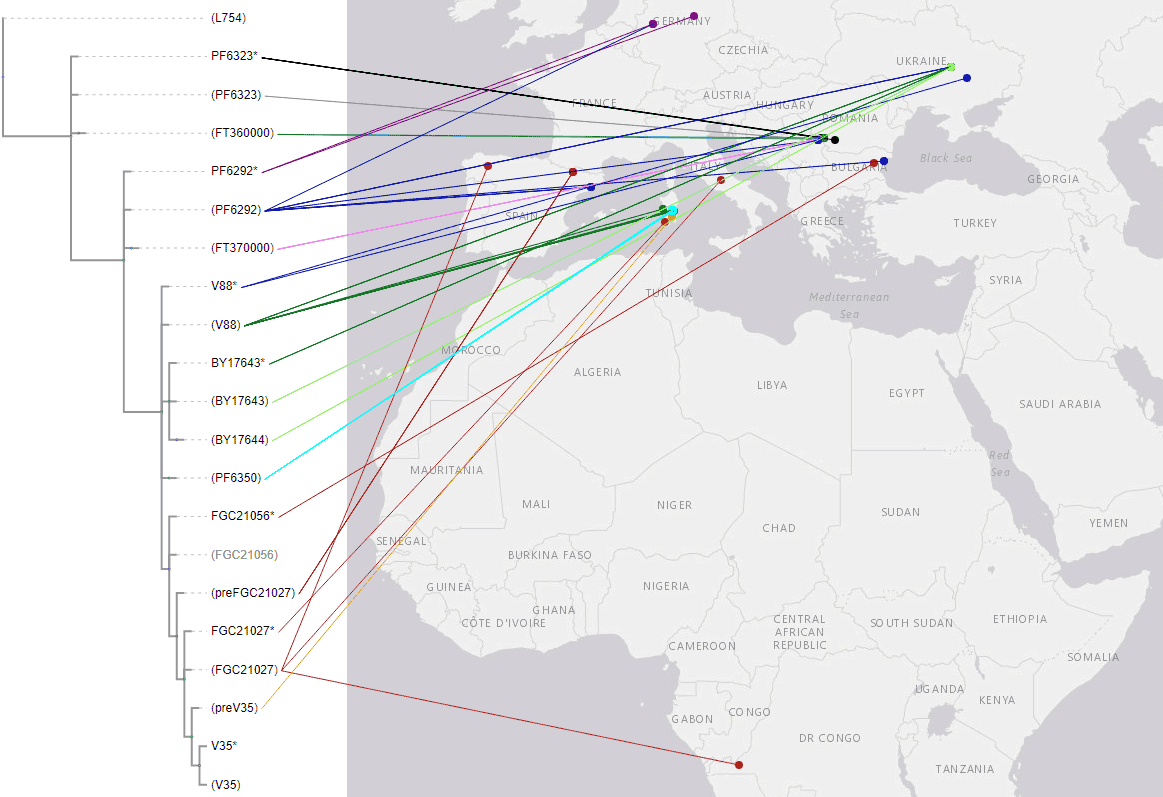
R-BY14355
R1a
R-M459
This sample joins other two Eastern European basal R1a subclades:
PES001 • R-YP1301 • Veretye • Peschanitsa, Arkhangelsk (10785–10626 calBC).
I5876 • R-YP5056 • Ukraine_Mesolithic • Dereivka (7040-6699 calBCE).
R-PF6162>Z93
R-Z93>Z94>Z2124>Z2125>S23592
NOTE. Some of these form part of Family A (3 members): I6718 is the father of son I3393, who is a 2nd or 3rd degree relative of I3394.
These basal R-S23592* and downstream R-FGC56408* lineages that split the S23592 trunk and their presence in the Minusinsk Basin – the traditional location of Proto-Samoyed after the demise of the Afanasievo culture – as well their continuation into the Tagar period, offer further support to the nature of the easternmost Cherkaskul expansion as Pre-Proto-Samoyedic, and of the Cherkaskul territory as a whole (where many R-S23592 samples have been found) as representative of the Eastern Uralic expansion. Materials from the Orak burial ground show Fëdorovo and Karasuk traits, which fits with an assumed Cherkaskul context and its continuation into the Early Iron Age.
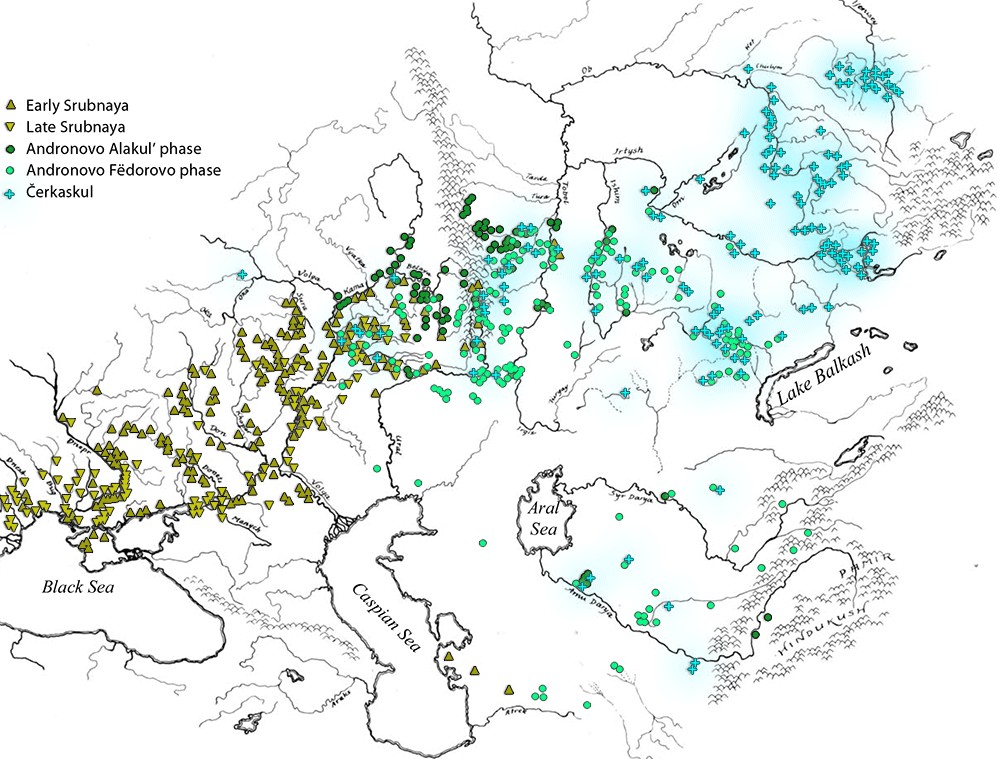
R-Z93>Z94>Z2124>Z2125>Z2123>Y874
NOTE. Part of Family D (2 members): I1054 (Z2123+) and I1053 are 1st degree relatives, so both are of basal hg. R-Y874*.
Other ancient samples from the same likely Indo-Iranian-speaking population of the Kamennyi Ambar 5 cemetery check out as patrilineally related to them:
I0987 • R-Y874 • Western_Steppe_MLBA • Kamennyi Ambar 5 Cemetery (2050-1700 BCE).
I1027 • R-Y874 • Western_Steppe_MLBA • Kamennyi Ambar 5 Cemetery (2008-1773 calBCE).
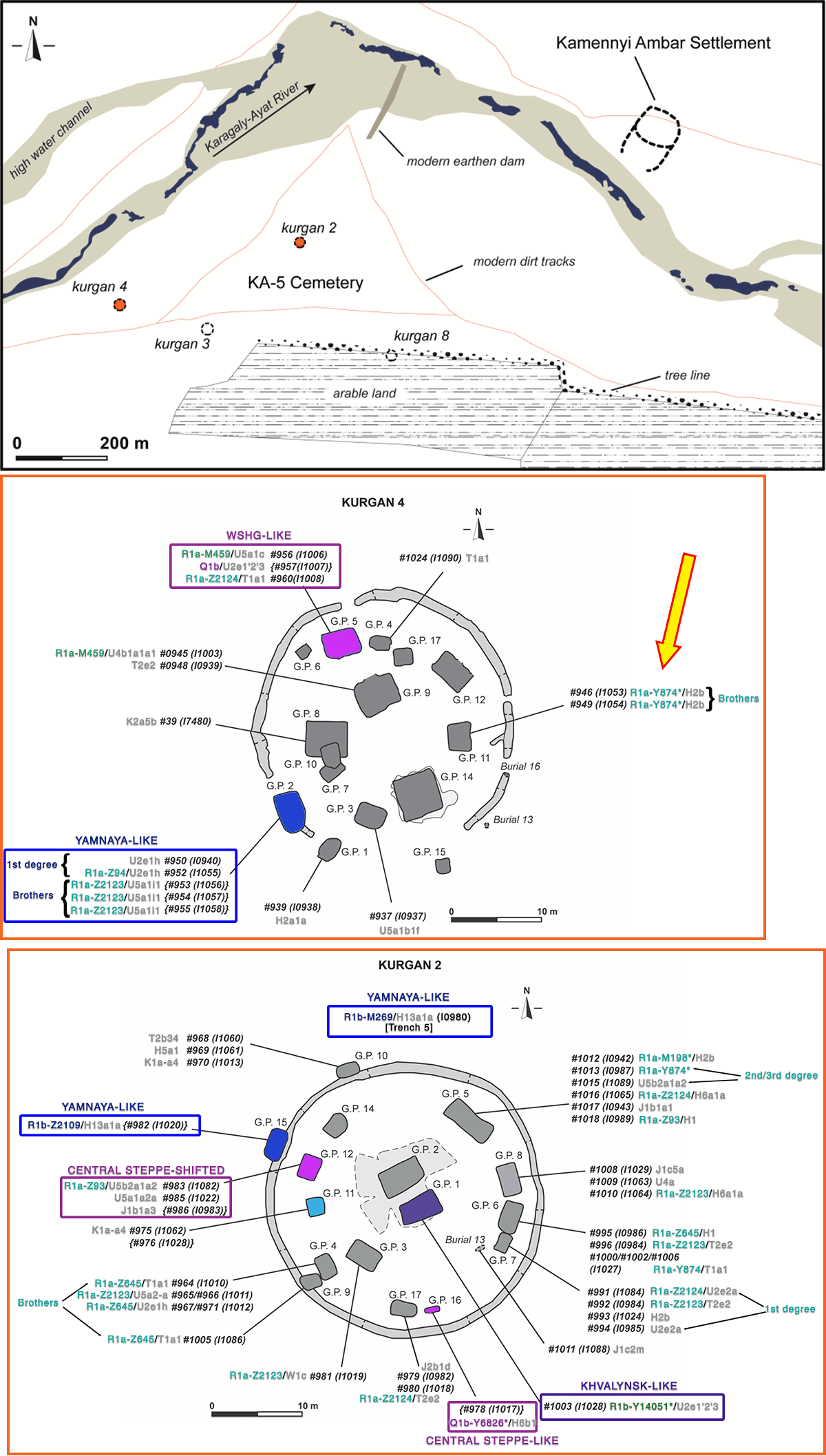
R-YP4141
I4773 splits the current R-YP4132 branch.
Together with the R1a-M198* from Central European Corded Ware and Sintashta, this R1a-YP4141 lineage spreading with Steppe_MLBA ancestry supports that the Proto-Corded Ware community originated in some R1a-rich population of the north Pontic region.
R2
Q1b
Q1b-L53
Q1b-L53>L54>CTS3814
These ancient Q-M3 individuals from North-Eastern Asia and the Americas join another subclade recently sampled and analyzed by FTDNA:
BER001 • Q-pre-L804 • Volosovo/Lyalovo • Berendeyevo, Yaroslavl (4447–4259 calBC)
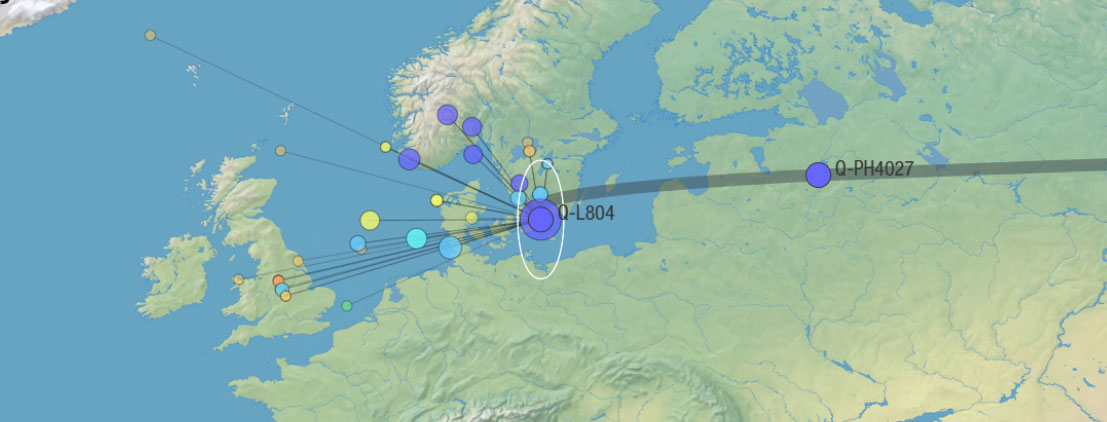
Q1b-L53>L54>CTS3814>CTS11969
Q1b-L53>L54>L330
The I6356 sample offers the first post-EBA hg. R-Y11938, a lineage attested in the only two high-coverage Ket male samples publicly available (from Flegontov et al. Sci Rep 2015). Their so-called “Ket-Uralic” ancestry is also shared with Scytho-Siberians and other Iron Age nomads spreading during the Late Bronze Age and Iron Age.
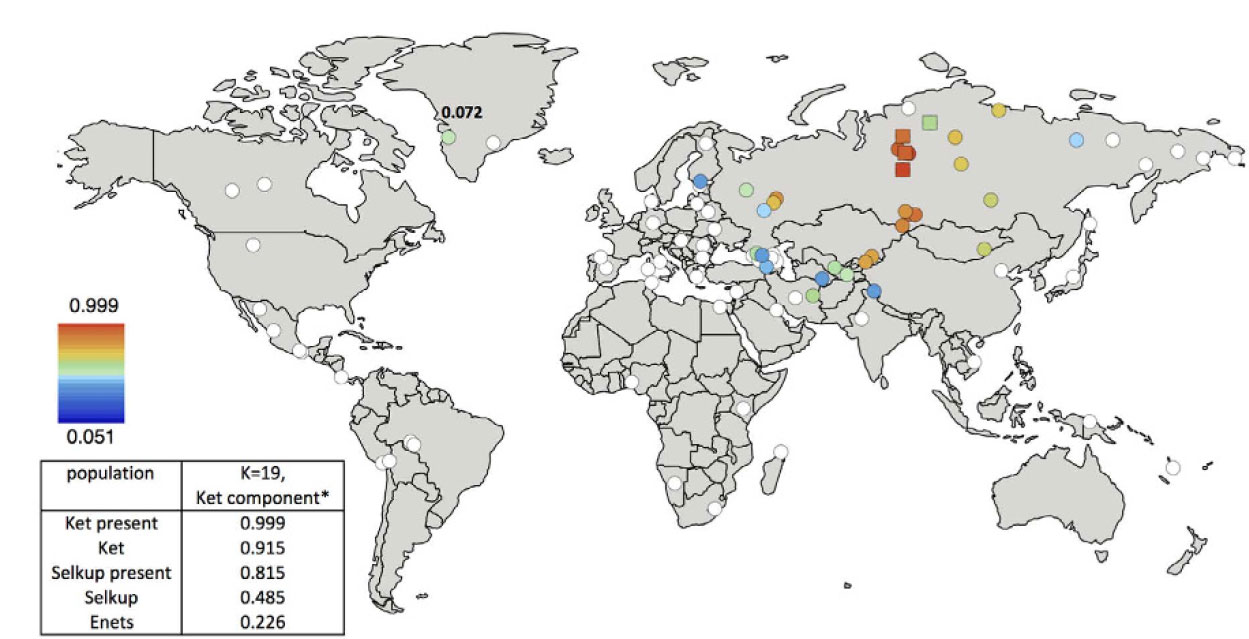
Q1b-L53>YP4010
This sample joins the Neolithic and EBA Q-YP4010 lineages from the Cis-Baikal area, as well as more recent samples from Northern Eurasia.
Q1b-Y4800
Q1b-Y4800>F1161>F1513>L932
Q1b-Y4800>SK1932
The same SK1932 subclade is also found in Steppe_EMBA, in the Lola culture, and in a much later medieval sample from Lebanon. Possibly connected thus to the hypothesized spread of WSHG ancestry into the Caucasus and the particular “Steppe” ancestry of Steppe_Maykop individuals.
L
E1b
J2
J2b
J2a
I0708 creates a new branch upstream of J-PH439 (it is a J-pre-PH439 sample).
I2
I2-P37
I2-P37>CTS595
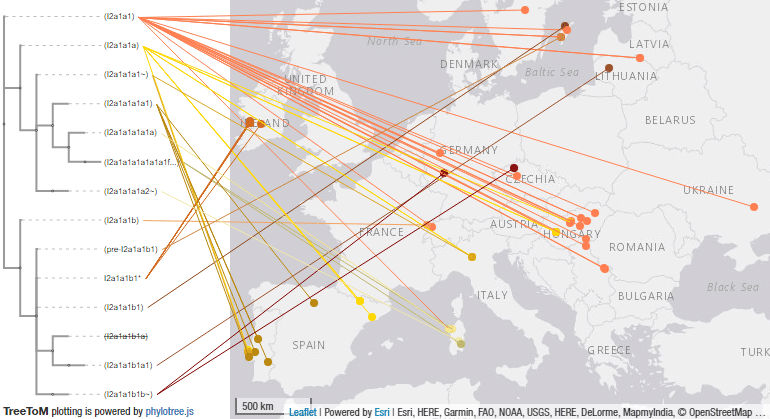
I2-P37>M423
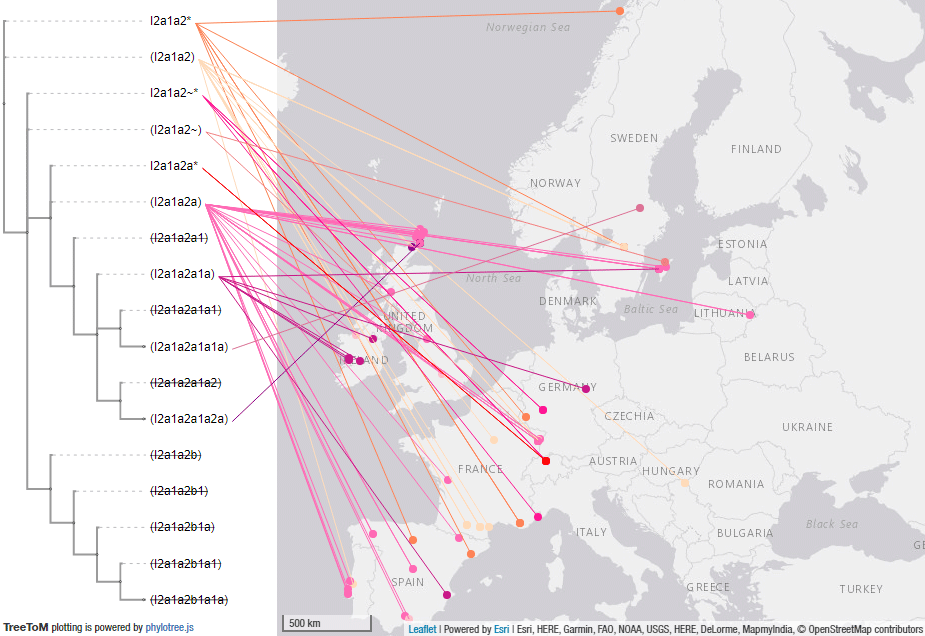
I2-P214
I2-P214>M223>P222>CTS616
One of the most interesting samples for future studies of Celtic peoples (see above under R-DF13) from the UK includes the R-Y3712 lines surviving in Scotland:
VK201 • I-B293 • Pict Orkney • Orkney (404-596 calCE).
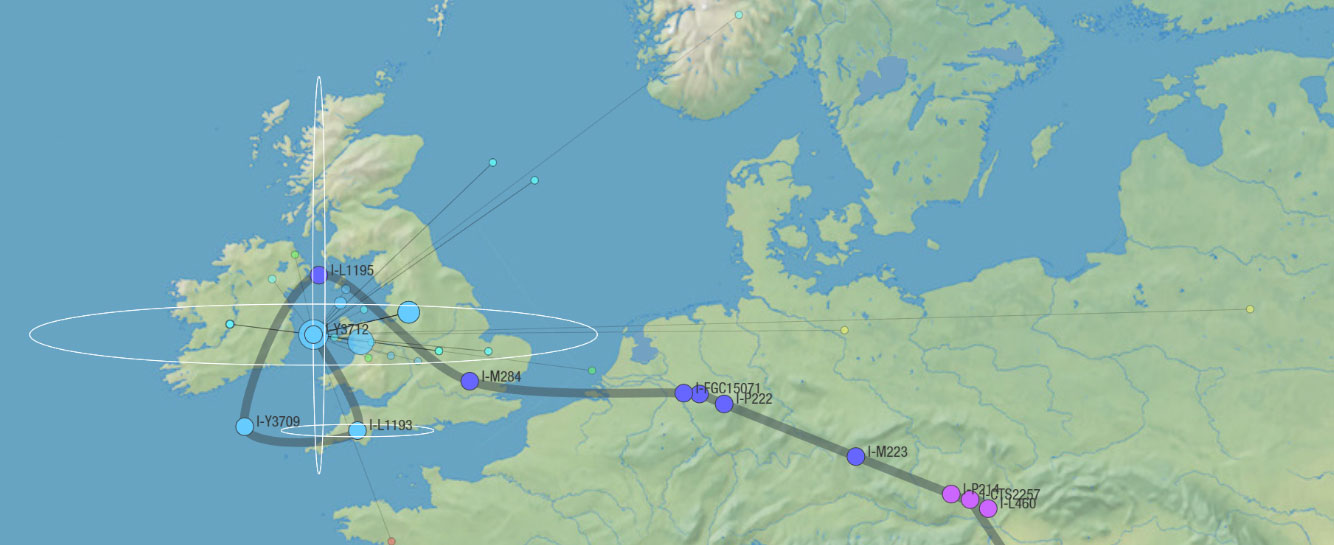
I2-P214>M223>P222>S9403
I2-P214>S2599
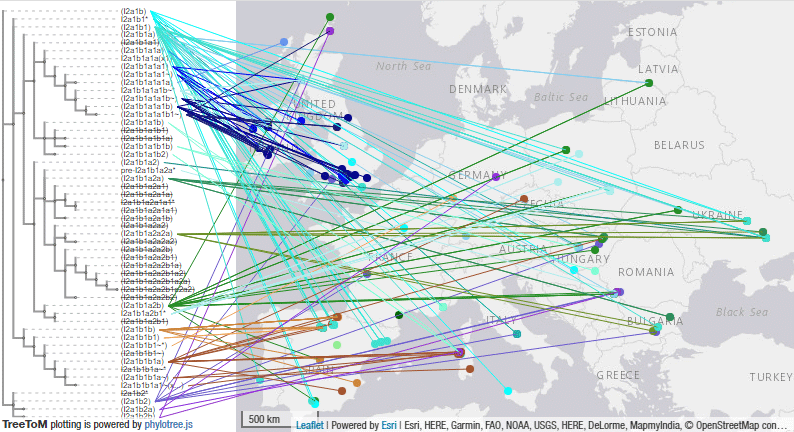
H
H1
H2-P96
A recent study by Rohrlach et al. bioRxiv (2021), on new DNA enrichment assay that targets the “mappable” regions of the NRY, focuses on ancient Y-chromosome H2 lineages.
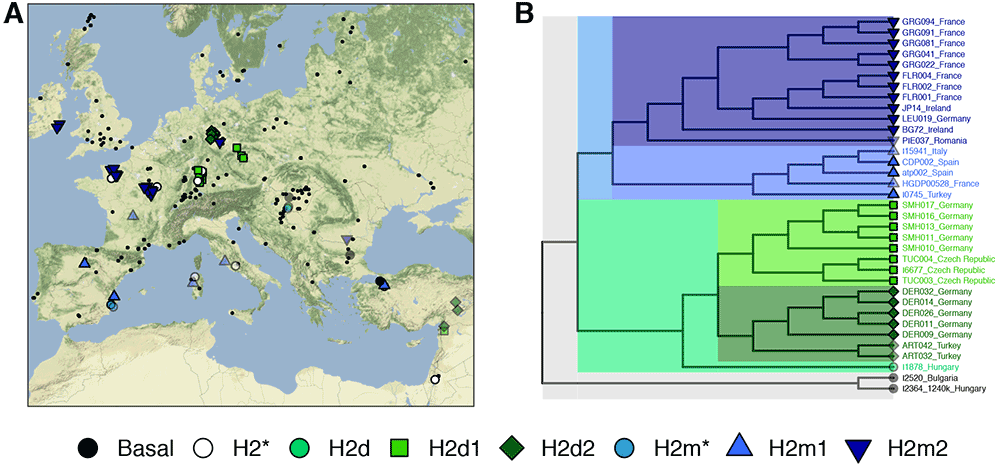
colours indicate the four major clades inferred from the phylogenetic tree. Image modified from Rohrlach et al. bioRxiv (2021), see the preprint for more on the details of the image.
G2
G2a-L30
G2a-PF3148
C
C1a-V20
Three new samples are added to the Palaeolithic, Mesolithic, and Neolithic C-F3393 samples already analyzed by FTDNA:
BB7-240 • C-F3393 • Initial Upper Palaeolithic • Bacho Kiro Cave (46130-44400 calBP).
Sunghir1 • C-V3177 • Mid Upper Paleolithic • Sunghir (32326-30080 calBCE).
Sunghir4 • C-CTS10356 • Mid Upper Paleolithic • Sunghir (32898-31771 calBCE).
Sunghir2 • C-Y37021 • Mid Upper Paleolithic • Sunghir (33833-31486 calBCE).
Sunghir3 • C-Y37021 • Mid Upper Paleolithic • Sunghir (33685-31328 calBCE).
I0585 • C-FT368070 • NW_Iberia_HG • La Braña-Arintero, León, Castilla y León (5982-5741 calBCE).
CC7-335 • C-FT409300 • Initial Upper Palaeolithic • Bacho Kiro Cave (46790-44830 calBP).
Kostenki14 • C-FT409300 • Kostenki14 • Kostenki (37426-34726 calBCE).
C2a-F11350
Other FTDNA tested individuals within the C-B77 are:
GLZ002 • C-BY728 • Angara EBA • Irkutsk city (2568-2350 calBCE).
KAG001 • C-BY728 • Lena EN • Lena river (4980-4841 calBCE).
UKY001 • C-BY728 • Selenga Terminal Paleolithic culture • Eastern Siberia (12100-11858 calBCE).
I7021 • C-B77 • Mongolia_N_East • Dornod aimag, Bulgan sum, Norovlin Uul burial (5211-4995 calBCE).
I11698 • C-pre-F25764 • Mongolia_N_North • Bulgan, Khutag-Undur sum, Marzyn khutul (5630-5483 calBCE).
I13698 • C-pre-F25764 • Mongolia_N_North • Bulgan, Khutag-Undur sum, Egiin-gol river valley, Marzyn Khutul (5621-5482 calBCE).
I7341 • C-F25764 • Old Bering Sea • Ekven, Chukotka (710-990 calCE).
I20755_I20777 • C-F25764 • Ekven_EMA • Ekven, Russia (1,400-900 ybp).

